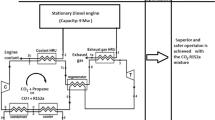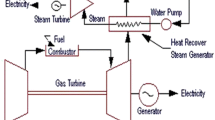Abstract
Following decades of laboratory research and nearly zero carbon emissions, supercritical carbon dioxide (S-CO2) gas turbine power plants are poised to replace steam power plants. A S-CO2 gas turbine power plant can provide sustainable power generation systems for higher plant operations’ efficiency. However, the purity of the working fluid is one of the power plant’s most crucial sustainability factors, and it must be analyzed and fully understood. This work aims to investigate the effect of common impurities on the 10 MW S-CO2 gas turbine performance, using the software program reference fluid thermodynamic and transport database version 10 to calculate pure and mixed CO2 and determine the fluid density at the main compressor inlet. The analysis reveals that non-condensable impurities in N2, O2, Ar, CH4, and He have a negative effect on the cycle performance. The presence of 1 % impurity in O2, CH4, Ar, N2, and He in 99 % rich CO2 decreases the cycle efficiency from 48.25 % to 47.27 %, 44.86 %, 44.12 %, 35.71 %, and 23.95 %, respectively. The results show that the presence of 1 % He raises the turbine and recompressor inlet temperatures from 973.15 K to 1774.9 K and 361.37 K to approximately 801.52 K, respectively. Impurities such as CH4 and O2 must have limited tolerance, whereas N2 and He must have a zero-tolerance level. The condensable impurities in H2O, H2S, and SO2 have a positive effect on the cycle efficiency. The presence of 1 % in H2O, H2S, and SO2 in 99 % CO2 increases the cycle efficiency by 2.3 %, 1.7 %, and 1.2 %, respectively, and can corrode turbine blades and materials. Continued work is necessary to fully understand the effects of impurities in the working fluid of an S-CO2 gas turbine power plant performance over time so as to ensure quality construction and safe and efficient operations.
Similar content being viewed by others
References
Q. Zhu, Innovative power generation systems using supercritical CO2 cycles, Clean Energy, 1 (1) (2017) 68–79.
K. Brun, P. Friedman and R. Dennis, Fundamentals and Applications of Supercritical Carbon Dioxide (sCO2) Based Power Cycles, Woodhead Publishing, Sawston (2017).
W. Ahmed and A. Javed, CO2 as a working fluid in geothermal power plants: comparison of recent studies and future recommendations, Proceedings the Thirty-Nine Workshop on Geothermal Reservoir Engineering (2014) 24–26.
S. Wright, P. Pickard, R. Fuller, R. Radel and M. Vernon, Supercritical CO2 compression loop operation and test results, Proceedings of SCCO2Power Cycle Symposium (2009) 29–30.
M. Anderson, J. Sienicki, A. Moisseytsev, G. Nellis and S. Klein, Advanced Supercritical Carbon Dioxide Brayton Cycle Development, Technical Report, Battelle Energy Alliance, LLC (2015).
S. Wright, C. Davidson and W. Scammell, Thermo-economic analysis of four SCO2 waste heat recovery power systems, Fifth International SCO2Symposium, San Antonio (2016) 28–31.
Z. Wang, Effects of impurities on CO2 geological storage, Ph.D. Thesis, University of Ottawa, Canada (2015).
L. Vesely, K. Manikantachari, S. Vasu, J. Kapat, V. Dostal and S. Martin, Effect of impurities on compressor and cooler in supercritical CO2 cycles, Journal of Energy Resources Technology, 141 (1) (2019) 012003.
E. W. Lemmon, I. H. Bell, M. L. Huber and M. O. McLinden, NIST Standard Reference Database 23: Reference Fluid Thermodynamic and Transport Properties-REFPROP, Version 10.0, National Institute of Standards and Technology, Standard Reference Data Program, Gaithersburg (2018).
R. Span and W. Wagner, A new equation of state for carbon dioxide covering the fluid region from the triple-point temperature to 1100 K at pressures up to 800 Mpa, Journal of Physical and Chemical Reference Data, 25 (6) (1996) 1509–1596.
J. J. Dyreby, Modeling the supercritical carbon dioxide Brayton cycle with recompression, Ph.D. Thesis, University of Wisconsin-Madison, USA (2014).
M. Persichilli, A. Kacludis, E. Zdankiewicz and T. Held, Su percritical CO2 power cycle developments and commercialization: why sCO2 can displace steam, Power-Gen India & Central Asia 2012, New Delhi (2012).
A. Moisseytsev, Passive load follow analysis of the STAR-LM and STAR-H2 systems, Ph.D. Thesis, Texas A&M University, USA (2004).
P. Hejzlar, M. J. Driscoll, J. Gibbs, Y. Gong, N. Carstens and S. P. Kao, Overview of supercritical CO2 power cycle and comparison with other cycles, Symposium on Supercritical CO2Power Cycle for Next Generation Systems, Cambridge (2007).
C. Kalra, D. Hofer, E. Sevincer, J. Moore and K. Brun, Development of high efficiency hot gas turboexpander for optimized csp supercritical CO2 power block operation, The 4th International Symposium-Supercritical CO2Power Cycles, Pittsburgh (2014).
C. Okezue and D. Kuvshinov, Effect of chemical impurities on centrifugal machine performance: implications for compressor sizing in a CO2 transport pipeline, Energy Procedia, 142 (2017) 3675–3682.
H. I. Saravanamuttoo, G. F. C. Rogers and H. Cohen, Gas Turbine Theory, Pearson Education, London (2001).
V. Dostal, A supercritical carbon dioxide cycle for next generation nuclear reactors, Ph.D. Thesis, Massachusetts Institute of Technology, USA (2004).
A. Chapoy, M. Nazeri, M. Kapateh, R. Burgass, C. Coquelet and B. Tohidi, Effect of impurities on thermophysical properties and phase behaviour of a CO2-rich system in ccs, International Journal of Greenhouse Gas Control, 19 (2013) 92–100.
C. W. White and N. T. Weiland, Evaluation of property methods for modeling direct-supercritical CO2 power cycles, Journal of Engineering for Gas Turbines and Power, 140 (1) (2018) 011701.
M. Mahlobo, K. Premlall and P. Olubambi, Effect of SO2 concentration as an impurity on carbon steel corrosion under subcritical CO2 environment, IOP Conference Series: Materials Science and Engineering, 272 (1) (2017) 012031.
N. P. Dasgupta, J. F. Mack, M. C. Langston, A. Bousetta and F. B. Prinz, Design of an atomic layer deposition reactor for hydrogen sulfide compatibility, Review of Scientific Instruments, 81 (4) (2010) 044102.
M. J. Hexemer, Supercritical CO2 Brayton recompression cycle design and control features to support startup and operation, The 4th International Symposium on Supercritical CO2Power Cycles, Pittsburgh (2014).
R. C. Downing, Pressure-enthalpy charts and their use, Service Application Manual, Refrigeration Service Engineers Society, Arlington Heights (2009).
S. R. Pidaparti, P. J. Hruska, A. Moisseytsev, J. J. Sienicki and D. Ranjan, Technical and economic feasibility of dry air cooling for the supercritical CO2 Brayton cycle using existing technology, The 5th International Symposium-Supercritical CO2Power Cycles (2016) 28–31.
Acknowledgments
The authors would like to acknowledge the CUBCL team and Mechanical and Aerospace Engineering Department.
Author information
Authors and Affiliations
Corresponding author
Additional information
This paper is written based on the first author’s Ph.D. thesis.
Henry Saari is an Associate Professor at Carleton University, Department of Mechanical and Aerospace Engineering Ottawa, ON, Canada. He is the Lead Engineer of the CUBCL project. His research activities focus on development of lightweight materials for aircraft gas turbine blade applications, leading to improved efficiency and power output, and material compatibility for supercritical carbon dioxide gas turbines used for high efficiency power generation.
Ibrahim Ali received his Ph.D. in Mechanical and Aerospace Engineering, Carleton University, Ottawa, ON, Canada. He has 11 years of experience with GE heavy-duty gas turbine power plant as a gas turbine maintenance engineer. He obtained his B.S. in Mechanical Engineering from Higher Institute of Polytechnic Sebha Ly, M.Sc. in Electrical Engineering with Power Electronic from Bradford University, UK. His research interests include developing a condition monitoring system for a 10 MW S-CO2 gas turbine power plant.
Rights and permissions
About this article
Cite this article
Ali, I., Saari, H. Investigating the effect of impurities on components and efficiency of the 10 MW S-CO2 gas turbine power plant. J Mech Sci Technol 36, 4789–4796 (2022). https://doi.org/10.1007/s12206-022-0837-8
Received:
Revised:
Accepted:
Published:
Issue Date:
DOI: https://doi.org/10.1007/s12206-022-0837-8




